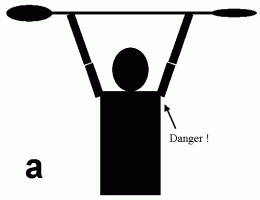Tuesday, August 22, 2006
Principles of kayak paddling strokes - Paddler's Box & Torso Rotation.
Paddler's Box & Torso Rotation protect against elbow tendonitis and shoulder dislocation.
Perfecting your paddle strokes is important both for performance on the water and for prevention of common paddler's injuries.1. Use torso rotation to power all paddling strokes because big torso muscles are stronger and have more endurance than skinny arm muscles. Wide separation of your hands on the paddle (see 90 degree rule in post "Holding the paddle") limits the range of motion you can get with elbow bending and helps force you to power the paddle with torso rotation.
2. Paddler's Box. Keep arms straight to efficiently transmit your torso rotation power to your paddle and to maintain your paddler's box (see paddlers box in post "Holding the paddle").
3. Keep hands and paddle down low (except for top hand on forward and other vertical strokes) to maintain a low center of gravity and keep the paddle blades in position for flat strokes like sweep and brace.
4. Elbow tendonitis. If you can get "tennis elbow" from a few hours per day of tennis, imagine how much damage you can do from all day long paddling trips. I got "paddler's elbow" a while back and lost many weekends of kayaking waiting for it to heal up. Then I learned how to paddle correctly with straight arms and haven't had any more sore elbows since then, despite many years of long and hard kayaking.
6. Bottom line. Both for better performance and for protection against common paddling injuries everybody should be sure to learn proper paddling technique. Lets all have fun, perform well and be safe out there !!!
More about: Kayaking Techniques.
Tags: kayaking, whitewater, rivers, paddling
Labels: technique







